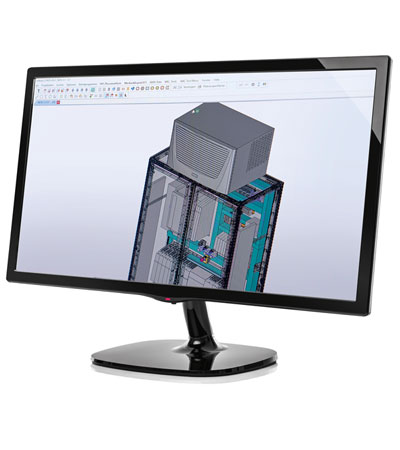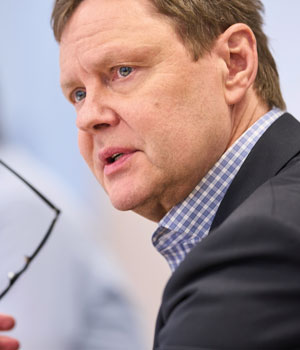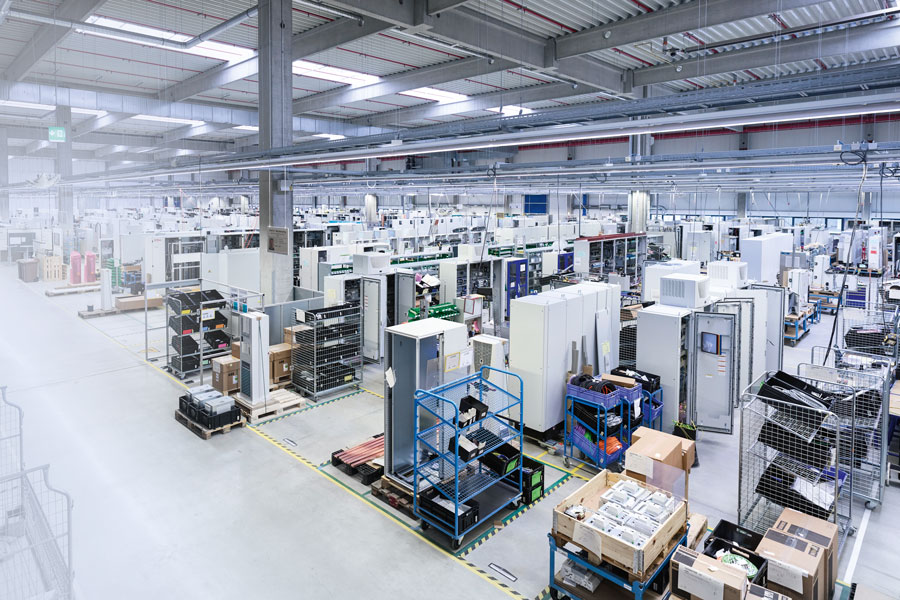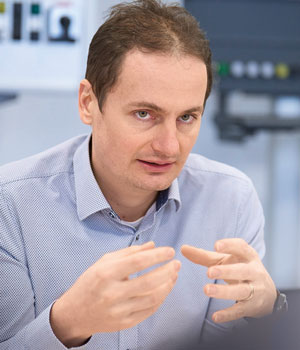Text Gerald Scheffels ––– Photography
The view looking out from the gallery over the hundreds of control panels being manufactured is genuinely impressive. How do you achieve that all-important transparency and efficiency in planning and production?
Kasparick: We made an early start, about 20 years ago in fact, on structuring specific technological and process know-how in our “digital twin”. Today, this approach means we can avoid doing the same work twice over and can cut our throughput time, both in our collaboration with customers, suppliers and partners and within our own value chain. As a result, we are generating benefits for customers and safeguard-ing our long-term competitiveness. That is the core of our strategy.
Let’s look at internal processes to start with. How does the digital twin for a project come about?
Kasparick: The first step is to transform technical information from our customers or our in-house Design Engineering team into digital values and save these in databases in a structured format. This produces a digital twin that complies with standardised specifications and is kept up to date throughout the course of the project. That means we’re working with an end-to-end data model – one that starts out in Design Engineering then passes through the Order Centre, Manufacturing Engineering, Assembly and Inspection, all the way to Dispatch. All the specifications for production – whether automated or manual – are derived from this model.
That then also means that the digital data model always matches the actual, physical control panel.
Kasparick: Exactly. The latest changes are adopted directly.
The data model has to be universal so it can be processed in different ways and in different systems. How do you achieve that?
Löffler: We have developed our own data model that can use Eplan Pro Panel data as a basis for incorporating additional information, processing it and outputting it so it’s compatible with our production operations. When it comes to cross-system standards, we are advocating for the Identification Link, the Asset Administration Shell and ECLASS Advanced as fundamental semantics. One of the first results is the digital product passport, which can be used to unequivocally allocate and process information about the product and its lifecycle. This gives companies a means to document their carbon footprint, for example, which is a requirement of the forthcoming EU taxonomy. That is a crucial customer benefit brought by digitalisation.
If we move on to the next step – production – can you tell us how your production systems are linked up to the digital twin?
Löffler: Our data model gives us flexibility when it comes to interfaces and enables us to supply workstations with machine data, robot data or information for people – all as appropriate to the specific workstation configuration. For instance, production data for drilling centres, milling centres, laser processing and wire processing is generated automatically the moment it is used in production. This is where the digital world and the real world come together.
To what extent are your customers aware of the digitalization in your company – how does it benefit them?
Löffler: They benefit from rapid throughput times, high quality and competitive prices, and also enjoy added value in engineering and production. The functional engineering we pursue enables us to generate modular and standard-compliant wiring plans. Our customers utilise this support precisely because many plant engineering companies have only limited capacities when it comes to electrical planning. If the engineering data we get from our customers is in a digital format, we can transfer it directly to our digital twin without having to convert or digitise it first. Production data, PCF values, export data, etc. are added to the digital twin as it makes its way through the plant. If required, the digital twin is also delivered to the customer in digital format along with the actual product itself. This approach enables us to eliminate all waste at the interfaces in customer-supplier relationships.
Theoretically, your customers – and suppliers, too – can benefit from the digital twin that you create on a customer-specific basis. Do they make the most of that?
Kasparick: There are some really good approaches amongst our suppliers when it comes to the provision of CAx data. Our customers are still somewhat restrained in their use of these options. However, we are confident that will change – certainly by the time new digital business models are being developed for cross-company cooperation, if not before.
When it comes to using the digital twin and automating control panel building, you have a clear lead on many competitors. Who are you working with and where are you finding partners to help you plan the next steps in automation and digitalisation?
Kasparick: These days, we talk to a range of solution providers. Rittal and Eplan are key partners for us, because they are really driving forward solutions for control panel building. That applies to the software side of things, but also to control panel products as well as to automation solutions and machines. That is why they are preferred suppliers and innovation partners for us. We pick up on ideas that they are developing to market readiness. We learn from each other, complement each other and talk to each other.
Löffler: Naturally, we’re also in close and regular discussion with our customers in the mechanical and plant engineering sectors. We both contribute to, and take inspiration from, this mutually beneficial collaboration.
Turning to the near future now, can we ask what kind of projects are underway? What do you think you and your partners should be working on?
Kasparick: The skills shortage is only too real, and we’re really feeling it. Besides promoting electrical engineering early on in local schools and through educational collaborations, we also need robust automation solutions so we can further optimise internal processes. One example of that would be automated wiring for very flexible wires.
Löffler: On a data level, that means the digital twin must be independent of whichever system has been used to create or process it. We need to standardise data exchange so that every engineering tool can play its part in creating data efficiently while ensuring that all the different factories in their widely varying configurations can still utilise the data that is accumulated.
Kasparick: One key factor is that climate-neutral energy management and low-carbon mobility are opening up whole new groups of customers. Energy needs to be distributed and sensors and actuators need to be connected across all these areas, and the best place to do that is in one central location – the control panel. The only way we can leverage this potential over the next few years is by pursuing efficient cross-company cooperation. It’s all about collectively standardising everything and developing digital information-sharing. This is where we want – and need – to do some convincing, both independently as the WKC, but also from within ZVEI, other organisations and with our more than 200 active customers.
Many thanks for talking to us!



